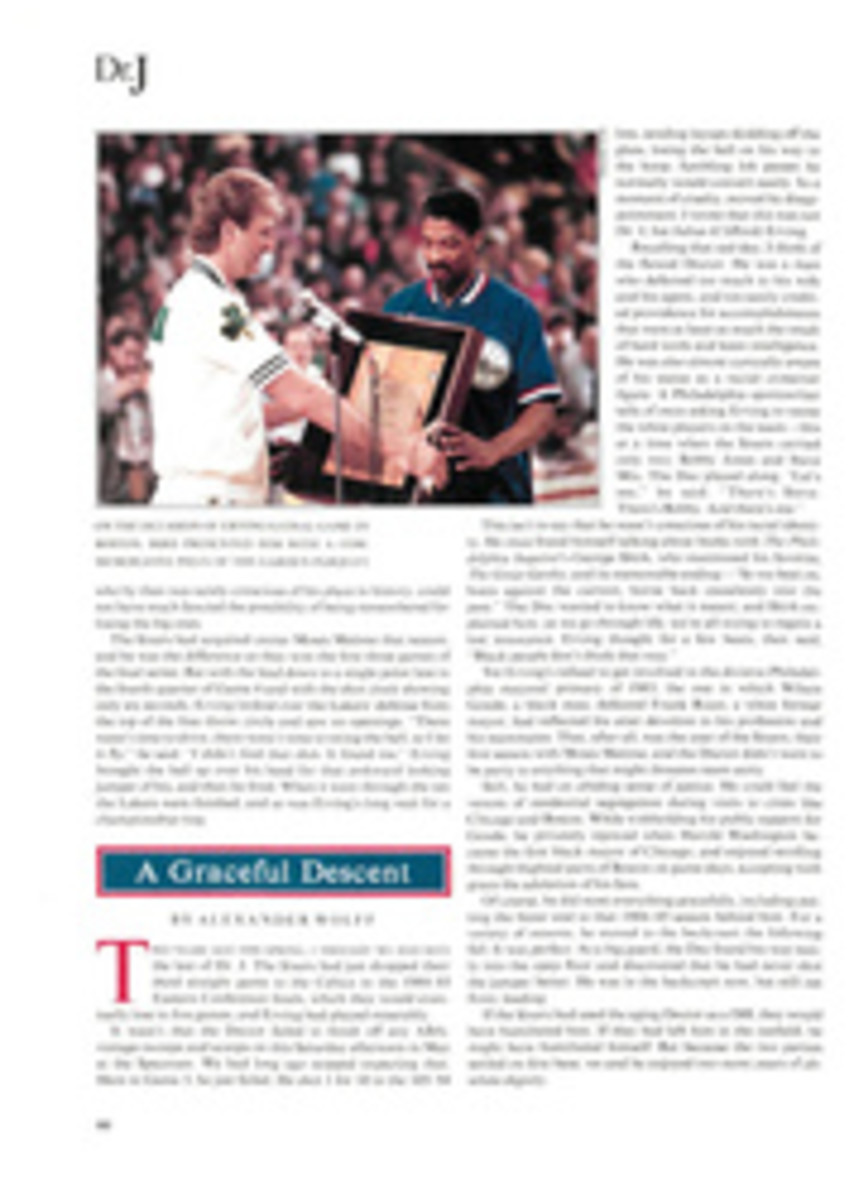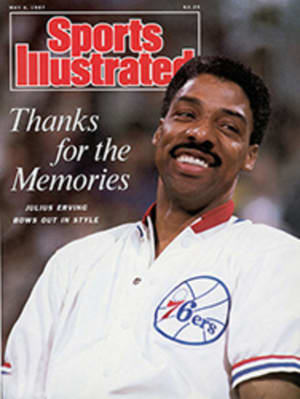
Doc Across America
Though the Philadelphia 76er season traversed a long and bumpy road, Julius Winfield Erving II never took a false step. He handled the NBA's longest goodbye, a 23-city, six-month farewell tour, with both elegance and dignity, words that describe his play on the court and his comportment off it. And, so, as his final days as a player draw near—by Sunday night the Sixers had split the first two games of their best-of-five Eastern Conference playoff series with Milwaukee—we remember Dr. J for what he was and what he has become...and we should be quite happy with both.
"I've never heard anybody knock him or express jealousy," says Atlanta's Dominique Wilkins. "Never one negative word. I can't name you one other player who has that status." Because there isn't one.
At each stop on the Doc Across America tour, he unfailingly did the right thing. In Seattle, on Nov. 11, he asked the crowd to pause and remember that it was Veterans Day. In Boston, on March 29, he seamlessly read the inscription on a commemorative plaque after Celtic president Red Auerbach had forgotten to do so. In New Jersey, on April 3, he came apart with just the right measure of emotion when his old ABA Nets jersey—No. 32—was lowered from the rafters. At Madison Square Garden, on April 6, he greeted Star Trek's Dr. Leonard (Bones) McCoy with a Vulcan salute. "Oh, yes, he did it perfectly," said DeForest Kelley, the actor who portrays McCoy. And on April 17, in Philadelphia, he lent dignity to an otherwise rambling Spectrum farewell ceremony and excitement to an otherwise meaningless game against Indiana.
During his pregame speech, he chastized the 76er organization, diplomatically but unmistakably, for failing to create a "family tradition" on the team. "I'm the first player from this organization able to announce that this would be his last season here," said Erving, amplifying his remarks after the game. "Everyone else has either been cut, traded, waived or just kind of disappeared. Too many guys leave here on bad terms." Erving was almost one of them. Three years ago he was on owner Harold Katz's trading block, but a deal that would have sent him to the L.A. Clippers fell through. And throughout the summer of '86 he was courted as a free agent by the Utah Jazz—until Katz ultimately signed him to a final one-year contract estimated to be worth $1.7 million.
Erving, 37, played remarkably well in that final regular-season home game. He played like Dr. J, the man who brought the small forward position into its current prominence in the NBA, rather than like Julius Erving, the aging superstar who is finishing his career as the off-guard on a mediocre team that had the fifth-best record in the East this season. Needing 36 points in his final two games to become only the third player (with Kareem Abdul-Jabbar and Wilt Chamberlain) to score 30,000 points, Doc went out and got all of them in the first three periods against the Pacers (he finished with 38, eight more than his previous season high). He posted up his defenseless defenders, stormed to the basket with a variety of spin moves and bank shots, took alley-oop passes above the rim, got out on the break for a tomahawk dunk and even hit a three-pointer from the corner at the first-half buzzer. And when he finally reached the milestone on a turnaround jump shot at 5:01 of the third period, the 17,967 fans in the Spectrum knew they had seen something very special: An athlete had reached back and snatched a performance out of time.
Erving needed a game like that near the end of the tour to remind the basketball world that not only was he a fine human being off the court but, yes, he could play a little, too. So many overwrought tributes had been uttered by so many spokesmen in so many cities that sometimes the tour seemed to be a canonization rather than an athlete's farewell. Let Doc enter the Hall of Fame, please, before he enters the kingdom of heaven, because without the accomplishments of Erving the player, who made the All-Star team in each of his 16 professional seasons (five in the ABA, 11 with the Sixers), the accomplishments of Erving, the ambassador of sport, would not have meant nearly as much.
"There have been some better people off the court," said Laker coach Pat Riley wryly. "Like a few mothers and the pope. But there was only one Dr. J the player."
Few mothers or popes have gathered the kind of booty that Erving collected during his long final swing through the league. In Utah he got skis, and in Indianapolis he got the key to the city. In Los Angeles he got a rocking chair and in Boston, a piece of the parquet floor. In San Antonio he got calfskin boots and in Milwaukee, a Don Nelson fish tie. In Phoenix he got a doll handmade by Hopi Indians, and in Sacramento he got a machine that serves tennis balls. In Portland he got Kiki Vandeweghe as a defender. And in the City of Brotherly Love on April 20, the day after the end of the regular season, he even got his own parade, which attracted more than 30,000 spectators—and, regrettably, was marred by some looting of stores immediately afterward.
He also got trips and condos and trophies and portraits and plaques and lacquered balls and all manner of loot that Erving, a millionaire who co-owns the Philadelphia Coca-Cola Bottling Co. and various other businesses, did not really need. But all 23 NBA teams owe a debt to the good Doctor, and all of them wanted to make some kind of gesture of repayment. "Our league needed someone like Doc," said Gene Shue, Erving's first NBA coach and now a Sixers broadcaster.
And now Erving's indelible footprints are there for other superstars, like Isiah Thomas, Magic Johnson, Michael Jordan and Wilkins, to follow. "You have been an inspiration, a leader and a perfect role model for me and all other NBA players," wrote Thomas in a telegram to Erving before the All-Star Game on Feb. 8. "You have made the path much smoother for us younger guys to follow."
One couldn't have asked for a neater trick than the one Dr. J has been pulling off for the last 16 years: He redefined midair—while keeping both feet on the ground.
PHOTO
MANNY MILLAN
ERVING DAZZLED IN MANY WAYS DURING HIS 16 YEARS AS A PROFESSIONAL, BUT HIS SIGNATURE, WITHOUT ANY QUESTION, WAS THE SLAM.

